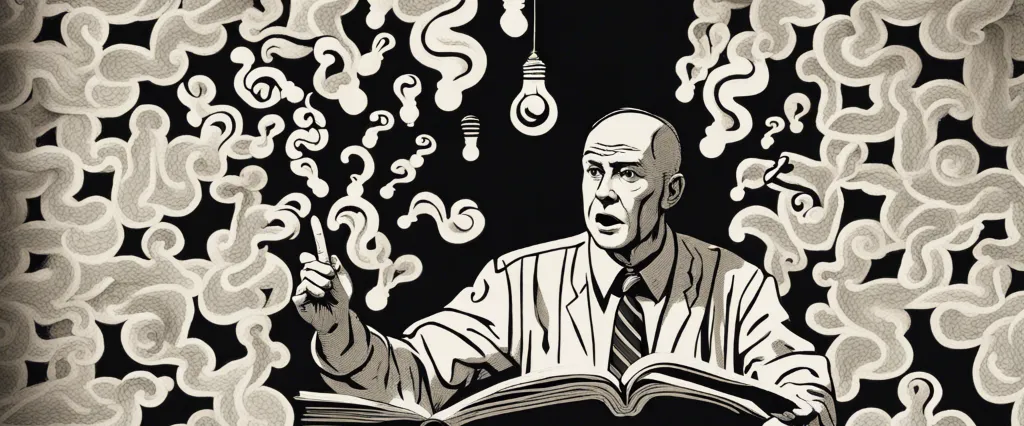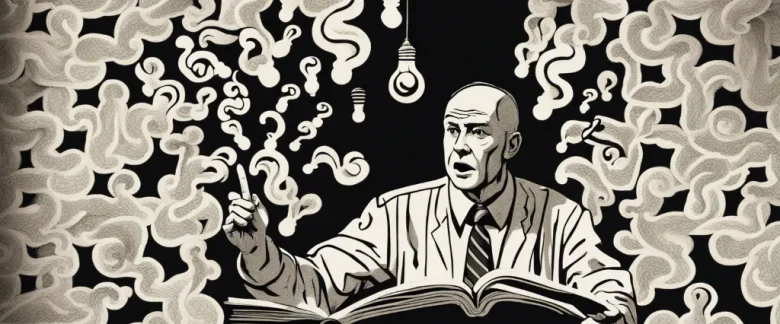
Eric Hoffer’s groundbreaking work, The True Believer, explores the psychological and social factors that drive individuals to join mass movements and embrace extreme ideologies. Published in 1951, this profound analysis continues to offer invaluable insights into the rise of fanaticism, appealing not only to scholars but also to a wider audience seeking to comprehend the dynamics of extremist behavior. Hoffer, himself a self-taught philosopher and longshoreman, gained recognition for his astute observations on human behavior, drawing from his own experiences and the turbulent period between the two world wars. In The True Believer, Hoffer delves deep into the motivations behind these extraordinary movements while examining the common mechanisms that lie at the heart of fervent adherence to causes, ultimately enabling us to comprehend the unsettling allure of fanaticism.
Chapter 1: The Nature of Mass Movements
Chapter 1: The Nature of Mass Movements, of the book “The True Believer” by Eric Hoffer, examines the fundamental characteristics and commonalities of mass movements throughout history. Hoffer argues that all mass movements, regardless of their ideological underpinnings, exhibit similar patterns and attract people who share certain psychological traits.
Hoffer first emphasizes that mass movements arise during times of societal instability and widespread discontent. He asserts that individuals who feel frustrated, hopeless, or dissatisfied with their current circumstances are more prone to embrace radical ideas and become part of a movement seeking social or political change. Furthermore, he notes that when a potential leader emerges who can effectively articulate the collective grievances and provide simple solutions, a mass movement gains momentum.
According to Hoffer, a distinguishing feature of mass movements is the fervor and fanaticism of their followers. He states that true believers wholeheartedly commit themselves to the cause, siding with the movement against the existing order and entirely surrendering their individuality. These individuals derive their satisfaction and identity from being part of a larger whole, merging their desires and ambitions with the collective movement.
Another key characteristic of mass movements, as outlined by Hoffer, is the interchangeability of objectives. Hoffer argues that mass movements often begin with specific goals, such as economic or political reform. However, as the movement expands, these objectives become secondary, and the zealots prioritize the fulfillment of the movement’s overarching principles, regardless of the original motives.
In conclusion, Hoffer posits that mass movements flourish in times of social upheaval, attracting individuals who feel discontented and seek radical change. These movements thrive due to the relentless dedication and fanaticism of their followers, who willingly surrender their individuality. Additionally, Hoffer highlights how the objectives of a mass movement often shift, with principles superseding the initial goals. By understanding these patterns, Hoffer provides an insightful exploration into the nature of mass movements and the psychology behind those who embrace them.
Chapter 2: The Appeal of Mass Movements
Chapter 2 of “The True Believer” by Eric Hoffer, titled “The Appeal of Mass Movements,” explores the underlying factors that attract individuals to become part of mass movements. Hoffer categorizes mass movements as “the desire for change, the substitution of death for life in significance, and the transfer of personal importance to a collective whole.”
According to Hoffer, mass movements offer a sense of purpose and meaning to individuals who feel unsatisfied or disillusioned with their lives. These movements enable people to escape their own personal identity and merge with a collective entity that promises a brighter future. By aligning themselves with a greater cause, individuals can transcend their mundane existence and feel a part of something greater.
Hoffer suggests that people are motivated to join mass movements due to their inherent sense of frustration, self-hatred, and lack of self-confidence. The frustrated individual strives for a sense of identity, an outlet for their grievances, and an opportunity to express their discontent.
Hoffer describes three types of frustrated people who are inclined to join mass movements: the misfits, who lack personal identity and seek to belong; the outcasts, who have suffered from real or imagined injustice and desire revenge; and the ambitious who, despite their achievements, crave acknowledgment and are willing to surrender their individuality to gain power.
In conclusion, Chapter 2 of “The True Believer” examines the psychological and emotional appeal of mass movements. It highlights the desire for change, the longing for significance, and the transfer of individual importance to a collective as the driving factors that compel individuals to become part of these movements.
Chapter 3: The Potential Converts: The Role of the Frustrated
In Chapter 3 of “The True Believer” by Eric Hoffer, titled “The Potential Converts: The Role of the Frustrated,” the author delves into the characteristics and motivations of individuals who are likely to be attracted to mass movements.
Hoffer argues that frustration plays a crucial role in converting potential followers into true believers. Frustration can result from a multitude of factors, such as economic hardships, deep-rooted personal insecurities, or a perceived lack of fulfillment. According to Hoffer, frustrated individuals tend to harbor feelings of self-doubt and pessimism, making them susceptible to the promises and allure of a mass movement.
The author explains that mass movements offer a sense of purpose and identity to those who feel lost or isolated. By joining a movement, individuals gain a renewed sense of meaning and belonging. The movement provides them with a sense of direction, convincing them that in following its doctrine, they can remedy their personal frustrations and transcend their perceived inadequacies.
Furthermore, Hoffer argues that potential converts are often socially marginalized, lacking strong ties to existing social structures. This isolation intensifies their feelings of frustration and makes them more receptive to the appeal of a mass movement.
Hoffer contends that mass movements rely on the frustrated and disillusioned for their growth and survival. These individuals are more likely to become passionate followers, as their personal frustrations fuel their zeal. By embracing the movement’s ideology, they find solace and a sense of self-worth.
In conclusion, Chapter 3 of “The True Believer” emphasizes the importance of frustrated individuals in the rise and sustainability of mass movements. Hoffer asserts that understanding the psychology and motivations of potential converts is vital in comprehending the dynamics and allure of such movements.
Chapter 4: United by Hatred: The Power of Scapegoating

Chapter 4 of “The True Believer” by Eric Hoffer, titled “United by Hatred: The Power of Scapegoating,” explores the role of scapegoating in mass movements and how it can unite individuals through a common enemy.
Hoffer begins by noting that mass movements often thrive on the presence of a scapegoat, an external enemy that can be blamed for the grievances and challenges faced by the adherents of the movement. Scapegoating serves several purposes: it simplifies complex issues, provides a target for pent-up frustration, and creates a sense of purpose and unity among the members of the movement.
According to Hoffer, the scapegoat acts as a unifying force that transcends individual differences among supporters of the movement. It allows people to channel their frustrations and discontent towards a common enemy, creating a shared identity and a sense of belonging within the movement. By blaming the scapegoat for their troubles, individuals can absolve themselves of personal responsibility and instead focus on collective action against this external threat.
Hoffer argues that the effectiveness of scapegoating arises from its ability to tap into deep-seated human emotions and desires. He suggests that individuals who feel insignificant or frustrated with their own lives are particularly susceptible to the appeal of a movement that offers them a chance to vent their frustrations by targeting a common enemy.
In conclusion, Chapter 4 of “The True Believer” explores how the power of scapegoating can rally individuals around a shared cause, fostering unity and purpose within a mass movement. By identifying an external enemy responsible for their troubles, individuals can find solace, identity, and a sense of belonging within the collective action against the scapegoat.
Chapter 5: The Fanatic’s Tactics: Action and Self-Sacrifice
Chapter 5 of “The True Believer” by Eric Hoffer, titled “The Fanatic’s Tactics: Action and Self-Sacrifice,” delves into the methods employed by fanatics to mobilize and unite their followers. Hoffer explores the dynamic nature of mass movements and the importance of action and self-sacrifice in their progression.
According to Hoffer, fanatics employ tactics that aim to ensure the commitment and obedience of their followers. The fanatic’s ultimate goal is to stir action, regardless of the cause’s rationality or morality. Action is seen as indispensable in maintaining the fervor and momentum of the movement. To achieve this, the fanatic often utilizes a doctrine that demands total dedication and sacrifice from its adherents. By emphasizing self-sacrifice, the fanatic creates a sense of purpose and unity within the movement, as individuals become deeply invested in the cause.
Hoffer argues that fanatics are adept at manipulating a wide range of individuals, including those who are unwell, impulsive, or frustrated, as they are more likely to embrace radical beliefs. The fanatic strives to exploit the feelings of discontent or inadequacy harbored by potential converts by offering them a new identity and a chance to belong to something larger than themselves.
Furthermore, the fanatic glorifies violence and martyrdom, as such sacrifices are considered the ultimate act of commitment to the cause. This glorification helps enforce the obedience and conformity of followers, as they seek to emulate the revered martyrs. These tactics ultimately feed into the fanatic’s aim to establish a highly loyal and zealous following that is willing to both act and sacrifice for the cause.
In summary, Chapter 5 of “The True Believer” highlights the tactics employed by fanatics to mobilize and unite their followers. By emphasizing action and self-sacrifice, fanatics create a sense of purpose and unity within their movements. Through the glorification of violence and martyrdom, fanatics ensure obedience and conformity among their followers.
Chapter 6: The True Believer’s Personality: The Need for Identity
Chapter 6 of “The True Believer” by Eric Hoffer delves into the concept of the true believer’s personality and their need for identity. Hoffer argues that the appeal of mass movements lies in the opportunity they provide for individuals to escape their own insignificance and acquire a sense of identity and purpose through their affiliation with a larger entity.
According to Hoffer, the true believer is usually someone who is dissatisfied with their personal circumstances or feels a sense of self-worthlessness. They seek meaning beyond their own existence, hoping to be part of something greater. By joining a mass movement, they can shed their individual identity and merge it with the collective identity of the group.
The chapter identifies some common traits found among true believers. They tend to feel a profound sense of alienation and disaffection from society, often viewing themselves as outcasts. Additionally, they possess a fanatical passion for a cause or leader, holding unwavering loyalty and commitment. True believers are more inclined to act on their beliefs with fanaticism, as they see themselves as soldiers fighting for a higher purpose.
Hoffer also highlights the role of the leader in shaping the true believer’s identity. The leader becomes the embodiment of the cause or movement, providing a sense of direction and an anchor for the believer’s identity. Through identification with the leader, the individual gains a sense of purpose and can discard their personal insignificance.
In summary, Chapter 6 explores the true believer’s personality and their need for identity. Hoffer argues that individuals seek belonging and meaning through mass movements, which offer a collective identity that replaces their own. The chapter also discusses the common traits of true believers and the crucial role played by charismatic leaders in shaping their identity.
Chapter 7: The Inherent Dangers of Fanaticism
Chapter 7 of “The True Believer” by Eric Hoffer delves into the inherent dangers of fanaticism. Hoffer argues that fanatics are prisoners of their incessant desire to submerge their individuality into a collective whole, be it a religious, political, or ideological movement. Though fanaticism often results in destructive and violent behavior, it also offers a sense of purpose and an escape from personal feelings of insignificance.
Hoffer emphasizes that fanatics are driven by a deep sense of self-hatred and seek to alleviate this by surrendering their identities to a mass movement. They willingly sacrifice their personal autonomy and reasoning in favor of unquestioning obedience to the cause. As such, fanatics become susceptible to manipulation by charismatic leaders who exploit their vulnerabilities for personal gain.
Furthermore, Hoffer explores how fanatics thrive in times of social upheaval and widespread discontent. Such periods provide fertile ground for extremist movements to flourish, as people’s frustrations and grievances make them more receptive to radical ideologies. Fanaticism thrives on the breakdown of societal order, promising a new utopia in exchange for blind allegiance.
Hoffer cautions that fanaticism can be extremely dangerous, as it suppresses critical thinking and individuality. Followers become incapable of empathy towards opposing viewpoints, making compromise and peaceful resolution impossible. Fanatics are driven by a zealous desire to eradicate all that threatens their chosen cause, often resorting to violence and destruction.
In summary, Chapter 7 of “The True Believer” warns against the dangers of fanaticism. Hoffer exposes the psychological motivations behind fanatic behavior, exposes their susceptibility to manipulation, and highlights how social discontent fuels the rise of extremist movements. Ultimately, he emphasizes the need for society to recognize the perils of fanaticism and foster a culture that encourages critical thinking and tolerance.

Chapter 8: The Aftermath: Reflections on Mass Movements
Chapter 8 of “The True Believer” by Eric Hoffer, titled “The Aftermath: Reflections on Mass Movements,” delves into the aftermath and consequences of mass movements. Hoffer starts by explaining that mass movements typically lose their momentum and popularity after achieving their initial goals or after their leaders are no longer able to sustain the enthusiasm of their followers.
According to Hoffer, when a mass movement reaches its climax, it is marked by a feeling of despair and disillusionment among its followers. This is because their idealized vision of a utopian society is never fully realized, leading to frustration and bitterness. Hoffer argues that those who were once fanatical followers may either become cynics, leaving the movement altogether, or continue to blindly support the movement out of fear of being labeled traitors.
The author also points out that mass movements often survive by shifting their focus to external enemies or scapegoats. This allows them to redirect the frustration and aggression of their followers towards an external threat, thereby maintaining their cohesion. Hoffer suggests that this tactic helps prolong the existence of mass movements even when their original goals seem unattainable.
Furthermore, Hoffer warns of potential dangers when mass movements dissolve. He believes that the dissolution of a movement may result in discontented individuals with a propensity for violence. These individuals, having lost their sense of purpose, may seek new causes or become an easy prey for extremist ideologies.
In conclusion, Chapter 8 of “The True Believer” explores the consequences of mass movements as they lose their initial fervor. Hoffer emphasizes the disillusionment experienced by followers and the potential dangers that arise when these movements dissolve, leaving individuals with a sense of purposelessness and vulnerability to extremist ideologies.
After Reading
In conclusion, “The True Believer” by Eric Hoffer provides an insightful examination of the psychological and sociological factors underlying mass movements and the individuals who join them. Hoffer highlights the importance of understanding the nature of fanaticism and the motivations that drive individuals to become true believers. By exploring various historical and contemporary examples, Hoffer reveals the common patterns and characteristics that unite different mass movements across ideologies. Through his rigorous analysis, he encourages readers to critically examine their own beliefs and understand the potential dangers of unchecked devotion. Overall, “The True Believer” offers valuable perspectives on the power of mass movements and the complex dynamics that shape our society.
1. The Social Animal” by Elliot Aronson: This captivating book delves into the complex world of human behavior, exploring the impact of social influence and the power of persuasion on our everyday lives. Aronson combines insightful research with engaging storytelling to help readers understand the hidden forces shaping their decisions and actions.
2. The Undoing Project” by Michael Lewis: In this thought-provoking masterpiece, Lewis explores the remarkable partnership between psychologists Amos Tversky and Daniel Kahneman, whose groundbreaking research revolutionized the field of behavioral economics. Through their meticulous studies, they uncovered the biases and heuristics that sway our thinking, challenging our assumptions and revealing how our minds truly work.
3. Social” by Matthew D. Lieberman: After immersing yourself in Eric Hoffer’s “The True Believer,” “Social” provides an enlightening perspective on the human need for social connection. Lieberman, a distinguished neuroscientist, unravels the mysteries of the social brain, revealing how our relationships and interactions shape our emotions, thoughts, and even physical health. This book offers valuable insights into our fundamental desire for social belonging.
4. Sapiens: A Brief History of Humankind” by Yuval Noah Harari: If you enjoyed exploring the complexities of human behavior and society in the above books, you will be captivated by Harari’s sweeping narrative. “Sapiens” takes readers on an extraordinary journey through the history of our species, from the emergence of Homo sapiens to the unprecedented challenges and choices we face today. Delving into anthropology, biology, and history, Harari offers a fascinating look at the forces that have shaped our shared human story.
5. Influence: The Psychology of Persuasion” by Robert Cialdini: Building upon the themes explored in “The Social Animal” and “The Undoing Project,” Cialdini’s seminal work dives deep into the art and science of persuasion. Drawing on his extensive research, the author uncovers the universal principles that govern our responses to influence. This book equips readers with invaluable insights to navigate the complex world of persuasion, helping them become more informed decision-makers.
These five books provide a diverse and comprehensive exploration of human behavior, social influence, and the forces that shape us as individuals and societies. Each one offers unique perspectives, backed by extensive research, to deepen your understanding of the intricate workings of our complex human nature.




Comments
Nice post. I learn something totally new and challenging on websites